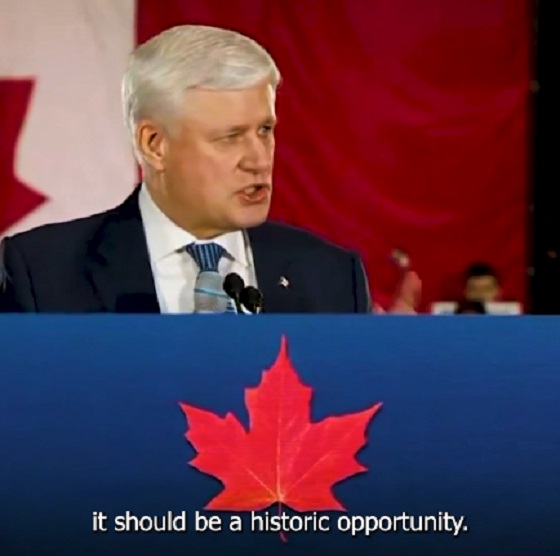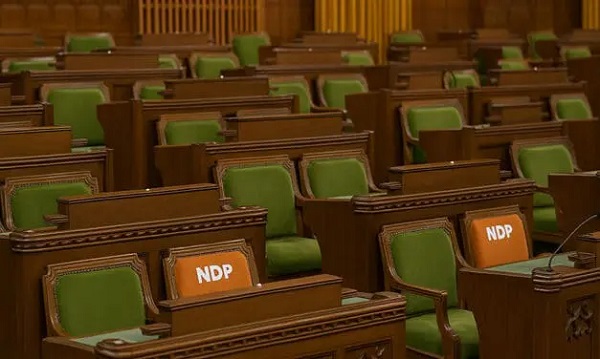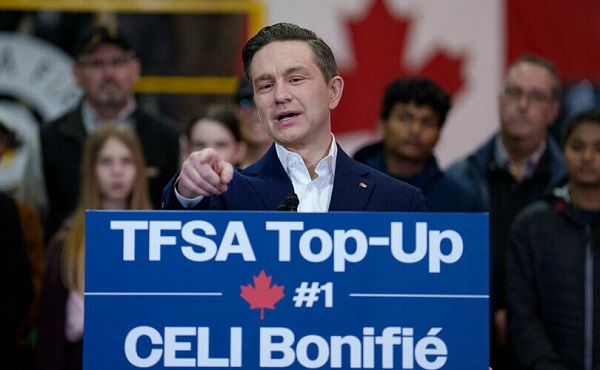2025 Federal Election
Harper Endorses Poilievre at Historic Edmonton Rally: “This Crisis Was Made in Canada”

Harper Endorses Poilievre, Slams the Liberals and Mark Carneys Record, and Exposes the Truth Behind Canada’s Decline.
Last night, in a massive warehouse just outside Edmonton, something extraordinary happened. Fifteen thousand Canadians showed up—not for a concert, not for a protest, but for a political rally. For one reason: to hear Pierre Poilievre speak. But the real shock? The man who introduced him.
Stephen Harper—the most successful Conservative prime minister in a generation—took the stage to deliver a blistering endorsement of Poilievre, and a scathing indictment of the Liberal regime.
He didn’t mince words. Harper said what every Canadian knows but no one in the press gallery will admit: this country needs change—desperately.
And he didn’t hedge. He didn’t qualify. He didn’t say “both parties have made mistakes.” No. Harper made it clear: this crisis—soaring costs, collapsing standards, vanishing jobs, growing division—it wasn’t created by Donald Trump. It was made right here. In Ottawa. By three terms of Liberal government and the Prime Minister who wants a fourth.
“These were not created by Donald Trump… They were created by the policies of three Liberal terms—policies the present Prime Minister supported.”
That’s as blunt as Harper gets. And it should be a headline on every newspaper in the country. But it won’t be. Because it hits too close to home for the elite class that’s spent nearly a decade covering for Trudeau’s failures.
Harper pointed out that the Liberals and their media allies are now trying to blame everything on geopolitics. Blame Trump. Blame supply chains. Blame COVID. Blame war. Blame anything but themselves. Because the truth? They can’t run on their record—so they’re running from it.
What is that record?
- Exploding debt
- Collapsing GDP per capita
- A federal bureaucracy that punishes work and rewards compliance
- A housing market that’s locked out an entire generation
- And an energy sector that’s been handed over to the Americans while Canadians sit unemployed on world-class resources
And now, as Mark Carney floats in with his $180 million CBC top-up and another round of green buzzwords, Harper reminded everyone: they’ve had their shot. Three terms. And they blew it.
He warned Canadians not to fall for the same routine again. Not to fall for the same slogans. Not to fall for the polished elites promising “solutions” to the very problems they created.
He reminded Canadians that while the Liberals talk about “fighting Trump,” they’re really just using the U.S. as a scapegoat for their own failures. And what did Harper offer instead? A rallying cry to seize this moment—not as an excuse—but as an opportunity to rebuild a truly independent Canada.
“The challenge from the United States… should not be another excuse for Liberal failure. It should be a historic opportunity.”
But the line that hit hardest? It was personal. Harper reminded everyone that he’s the only person alive who actually led Canada through the global financial crisis.
That little swipe at Mark Carney—you could feel the building rumble.
Carney wants credit for crisis leadership? Harper was running the country when the global economy was imploding. He knows what real leadership looks like—and he said flatly that Pierre Poilievre is the only one on the stage today who’s shown it.
Stephen Harper stood up and told the country what it needs to hear: Pierre Poilievre is ready to lead.
Not because of branding. Not because he’s a “fresh face.” Not because some elite committee in Ottawa thinks it’s his turn. No—because he earned it.
Harper laid it out plainly. Poilievre started in the back row. He built his career not on media hype or party privilege, but on policy work, persistence, and a rock-solid conservative vision. He wasn’t parachuted in. He wasn’t picked by insiders. He clawed his way up with substance.
“Pierre is not new to this. He’s been on the national scene for more than two decades. He has been in cabinet. He has been in opposition. He’s a serious policy-maker. A leader who has grown through experience.”
That’s what Stephen Harper said. And you could hear the crowd erupt when he said it.
Because Canadians are desperate—desperate—for someone who doesn’t just play politics, but actually understands the fight. Someone who knows how Parliament works. Someone who has taken on the gatekeepers—and won.
And Harper wasn’t just praising Poilievre’s résumé. He called him what the man actually is: an ideas-driven, battle-tested leader who has spent his entire career pushing back against the smug, bloated, bureaucratic class that now defines Ottawa.
“Pierre has always been guided by conservative values… smaller government, fiscal responsibility, and making this country work for those who do the work.”
Imagine that. A politician who talks about work—and means it.
Harper could’ve stayed silent. He’s done the job. He’s earned his peace. But he stepped into that warehouse in Nisku for one reason: to make it clear that this is Pierre’s moment—and Canada can’t afford to miss it.
“He is our leader. And he is the next Prime Minister of Canada.”
That wasn’t hyperbole. That was a warning shot to the Liberal machine. A message to the Laurentian elite, the smug consultants, the CBC newsrooms, and every Davos-friendly banker currently circling Ottawa like vultures: your time is up.
Stephen Harper didn’t back Pierre out of nostalgia. He backed him because he sees a real, competent, fearless leader—someone who knows that you don’t fix this country by managing the decline. You stop the decline.
Pierre Poilievre isn’t Trudeau with a different haircut. He’s the anti-Trudeau. He’s not trying to be liked by the press gallery. He’s trying to restore the country.
And if you want a Prime Minister who understands the value of work, who believes in the dignity of the individual, who will cut the red tape, slash the taxes, fire the gatekeepers, and take Canada back from the bureaucratic swamp—Harper made it clear:
There is only one choice.
Pierre Poilievre.
Subscribe to The Opposition with Dan Knight .
For the full experience, upgrade your subscription.
2025 Federal Election
NDP’s collapse rightly cost them official party status

This article supplied by Troy Media.
 By Michael Taube
By Michael Taube
Official party status requires 12 seats. The NDP got seven. End of story
Rules are rules.
That, in a nutshell, is why the NDP wasn’t granted official party status in the House of Commons on Monday. Prime Minister Mark Carney and the
Liberals, to their credit, made the right decision.
Let’s examine why.
The 1963 Senate and House of Commons Act passed an amendment that gave an annual allowance to party leaders other than the prime minister and
leader of the Opposition. In doing so, the Canadian government had to establish what constitutes a “political party.” The definition they came up with was a sensible one: it had to have a “recognized membership of 12 or more persons in the House of Commons.”
This important amendment is still used today.
The NDP fell from 24 to a paltry seven seats in last month’s federal election. (There are a total of 343 seats in the House of Commons.) They finished with 1,234,673 votes, or 6.29 per cent, which was behind the Liberals, Conservatives and Bloc Québécois. Party leader Jagmeet Singh, who had represented the former Burnaby South riding since 2019, finished a distant third in the newly created Burnaby Central riding and resigned.
The NDP’s seven seats is well below the 12-seat requirement needed for official party status. This means Canada’s socialist alternative won’t be able to ask questions in the House of Commons and will lose out on money for research purposes.
Or, to put it another way, they’re plumb out of luck.
Hold on, some people said. They pointed out that the NDP’s seat count and popular vote only plummeted because many progressive voters backed Carney and the Liberals as the best option to counter U.S. President Donald Trump and his tariffs. They felt that the NDP’s long history as a champion for unions and the working class should count for something. They suggested there should be an exception to the rule.
Guess what? They’re wrong.
This is the worst election result in the party’s history. Even its predecessor, the Co-operative Commonwealth Federation (CCF), did marginally better in its first campaign. The CCF won seven out of 245 seats—and earned 410,125 votes, or 9.31 per cent—in the 1935 election. Party leader J.S. Woodsworth, who had represented the riding of Winnipeg North Centre as an Independent Labour MP since 1925, comfortably held his seat.
Meanwhile, this won’t be the first time they’ve ever lost official party status.
The NDP dropped from 43 to nine seats in the 1993 election. It was a dismal showing, to say the least. There was a suggestion at the time that then-party leader Audrey McLaughlin, the first woman to lead a party with political representation in Canada’s House of Commons, deserved a better fate. While the NDP certainly came closer to achieving the 12-seat requirement in this particular election, Prime Minister Jean Chrétien and the Liberals decided against granting them official party status.
Why? As I mentioned earlier, rules are rules.
Then again, British pilot Harry Day notably told his fellow flying ace Douglas Bader in 1931, “You know my views about some regulations—they’re written for the obedience of fools and the guidance of wise men.”
Does this mean that individuals and organizations who follow rules are, in fact, fools? Not at all. While certain rules in a liberal democratic society can range from slightly questionable to utterly ridiculous, they’re usually put in place for a specific purpose.
In the case of the House of Commons, it’s to ensure that a bar has been set with respect to political representation. Is 12 seats the right number? That’s difficult to say. It certainly prevents small protest parties and one-issue parties that unexpectedly win a tiny number of seats in an election from acquiring power and status right off the bat. They need to win more seats and grow in size and stature to reach a point of respectability. Most of them never reach this point and disappear while others float in a constant state of mediocrity like the Green Party of Canada. ’Tis the nature of the political beast.
One final point. If Singh and the NDP had reached double digits in total number of seats in 2025, a solid case could have been made in favour of official party status. If they had finished with 11 seats, it would have almost been a lock. Neither scenario ultimately materialized, which is why Carney and the Liberals did exactly what they did.
Michael Taube is a political commentator, Troy Media syndicated columnist and former speechwriter for Prime Minister Stephen Harper. He holds a master’s degree in comparative politics from the London School of Economics, lending academic rigour to his political insights.
Troy Media empowers Canadian community news outlets by providing independent, insightful analysis and commentary. Our mission is to support local media in helping Canadians stay informed and engaged by delivering reliable content that strengthens community connections and deepens understanding across the country.
2025 Federal Election
Judicial recounts give Conservatives 2 more seats, keeping Liberals short of majority

From LifeSiteNews
After a judicial recount, Conservative candidate Kathy Borrelli has officially won over Liberal incumbent Irek Kusmierczyk, in the Ontario riding of Windsor-Tecumseh-Lakeshore.
Judicial recounts from the 2025 federal election have given the Conservative Party two new seats, with one candidate winning by just four votes.
After a judicial recount, Conservative candidate Kathy Borrelli has officially won over Liberal incumbent Irek Kusmierczyk, in the Ontario riding of Windsor-Tecumseh-Lakeshore.
Borrelli got 32,090 votes, with Kusmierczyk getting 32,086 votes, and NDP candidate Alex Ilijoski getting 4,240 votes.
In the Newfoundland riding of Terra Nova-The Peninsulas, Conservative candidate Jonathan Rowe beat out Liberal Anthony Germain by just 12 votes after a recount with the initial result showing a Liberal victory.
The new election results mean the Conservatives now have 144 seats with the Liberals at 169, three short of a majority.
Judicial recounts are automatically triggered when the margin of victory for a candidate is less than 0.1 percent of valid votes.
While these recounts have favored the Conservatives, others have gone in the Liberal Party’s favor.
A May 16 judicial recount switched the southern Ontario riding of Milton East-Halton Hills South to the Liberals with a 21-vote victory over the Conservatives.
Overall, the election results have been a big blow to the Conservative Party, which on top of losing the election also saw its leader, Pierre Poilievre, fail to win his long-held seat. However, Poilievre is expected to run in a yet-to-be-announced by-election in Alberta to reclaim a seat in Parliament.
-

 Crime11 hours ago
Crime11 hours agoHow Chinese State-Linked Networks Replaced the Medellín Model with Global Logistics and Political Protection
-

 Addictions12 hours ago
Addictions12 hours agoNew RCMP program steering opioid addicted towards treatment and recovery
-

 Aristotle Foundation13 hours ago
Aristotle Foundation13 hours agoWe need an immigration policy that will serve all Canadians
-

 Business10 hours ago
Business10 hours agoNatural gas pipeline ownership spreads across 36 First Nations in B.C.
-

 Courageous Discourse8 hours ago
Courageous Discourse8 hours agoHealthcare Blockbuster – RFK Jr removes all 17 members of CDC Vaccine Advisory Panel!
-

 Health4 hours ago
Health4 hours agoRFK Jr. purges CDC vaccine panel, citing decades of ‘skewed science’
-

 Censorship Industrial Complex7 hours ago
Censorship Industrial Complex7 hours agoAlberta senator wants to revive lapsed Trudeau internet censorship bill
-

 Crime14 hours ago
Crime14 hours agoLetter Shows Biden Administration Privately Warned B.C. on Fentanyl Threat Years Before Patel’s Public Bombshells





